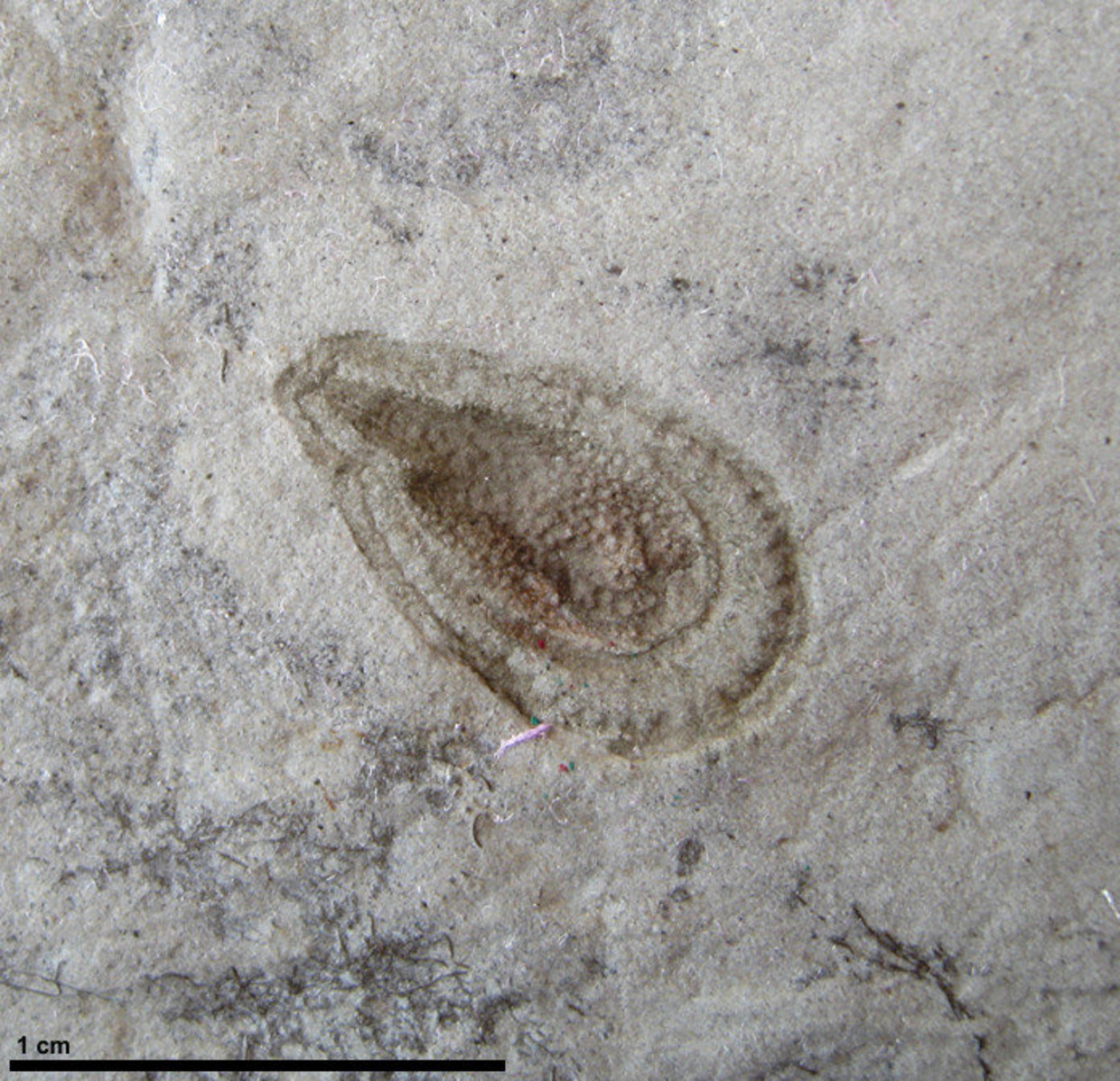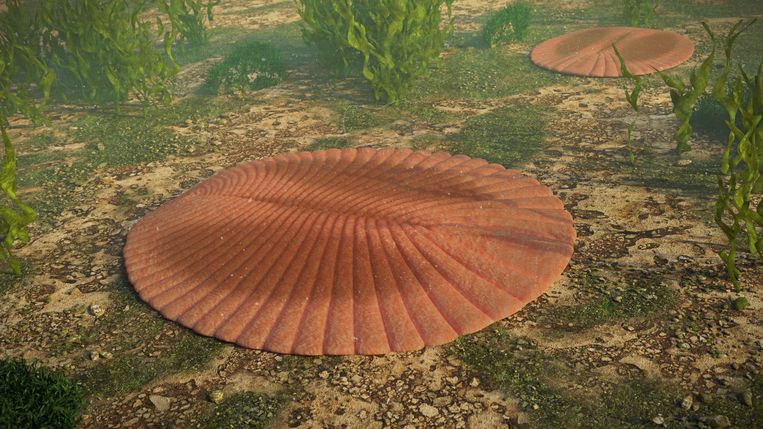They moved along the sea floor more than half a billion years ago. And it increasingly appears that these mysterious pointlike creatures may have been distant ancestors of today’s animals, and thus ours.
When the name “kimberella” appears, Emily Mitchell on the other end of the video connection begins to appear. “This is really cool.”
why? Traces of the animals, which look like a kind of teardrop-shaped slug with a marginal ring, show that they did not move randomly over the sea floor, but continued to search for a new piece of bacterial mat to graze. Mitchell: “They really knew where they were going. And it was very complex: the chimberella was obviously made of different types of tissue.”
If that was enough to make an animal special, you’d say the bar isn’t high. But those who want to understand the enthusiasm of Emily Mitchell – who studies ancient ecosystems at Cambridge University – should know that cambrilla lived a very long time ago, when the first organisms that scientists dared to call animals appeared. The sea floor at that time was full of strange creatures that looked like bubbling fish and pigeon mats, others more like erect feathers. By comparison, the Kimbrella appears to be already advanced.

However, primitive organisms at the time formed more complex societies than had long been thought, according to a recent publication in the scientific journal Plus Biology, of which Emily Mitchell is one of its authors. This insight has important implications for our understanding of animal evolution. It increasingly appears that these mysterious creatures may have been our distant ancestors.
They lived more than half a billion years ago, in the geological age called ediacarium, long before there were plants on Earth. Next to the cambrilla were animals such as Dickinsonia, a type of ribbed piece of tissue that could grow over a meter in size. Or take Ranga and Charnya, two species that have the appearance of feathers of birds that have stood upright on the sea floor and gently waved.
surrounded by question marks
This must have been the quietest time in the history of the animal kingdom: there was little or no hunting. They probably spent most of their lives lying around wandering, quietly feeding on algae and bacterial mats.
Moreover, these creatures are a great mystery. What are they related to – jellyfish, corals, snails perhaps? Surrounded by question marks. For a long time, scientists doubted whether they were looking for animal fossils, some of which look very strange. Perhaps those blobs were some kind of massive single-celled organism, as has been suggested, or a completely unique form of life that no longer exists.
According to Mitchell, this debate is largely settled. So Transformed in 2018After chemical analysis of the fossilized remains, Dickinsonia produced fatty acids found only in animal cells. British researchers concluded Based on detailed surveys of fossils, the feathered creatures had a plan to build animals.
The traces showing that some species were actively crawling indicate this. “It’s particularly compelling that so many different forms of evidence point to the same conclusion,” Mitchell says. Of course, it was not only animals that lived there, as in today’s oceans: other fossils seem to be the remains of, for example, colonies of algae and unicellular organisms.

The next question is what evolutionary steps have been taken in the point world. To learn more about this, Mitchell and colleagues from Cambridge examined how animal species live together. The question was to what extent they were sitting next to each other a little, or whether they had actually formed true communities. Just as the modern forest cannot be understood by studying a single tree, it is impossible to understand Ediacaran societies by looking only at individual fossils.
So the researchers conducted an extensive statistical analysis of tens of thousands of animal fossils that lived between 575 and 543 million years ago. For example, they looked at whether or not species lived together remarkably often. This may indicate that they somehow need each other or are in competition with each other. They also investigated the extent to which species prefer specific water depths or soil types. And the stronger that relationship was, the more the animals specialized.
‘Really complex societies’
It turns out that the oldest animals of the Ediacaran did not care much about each other and their environment. But as millions of years passed, species began to specialize in different environments and water depths. Interdependence and competition between species developed slowly but surely. “At the end of the Ediacarium, there were really complex societies,” Mitchell said.
This is astonishing, because the species richness of the fossils found seems to diminish towards the end. Some scientists interpret this as an extinction wave, possibly due to a hitherto unknown ecological catastrophe. The new findings suggest that something else was at play, Mitchell says: In fact, species continued to evolve and began to outgrow each other, reducing their local symbiosis. “We are seeing an increase in specialists. Don’t expect to see that after the extinction wave.”
Lydia Tarhan, a geologist at Yale University who researches Idiacarium and was not involved in this study was impressed. The new study sets new standards for research into ancient ecosystems, she wrote via email, from anecdotal comparisons between small numbers of fossils, to comprehensive statistical analyzes like this one.
According to Tarhan, the results are in line with other research from recent years. “This indicates that Ediacaran organisms were more complex and constituted more complex ecosystems than previously thought.”
This insight sheds light on the period leading up to a pivotal moment in the evolution of animal life: the Cambrian Explosion. It happened right after the idiacarium and is a resounding triggering signal for animal life as we know it today. In about 10-20 million years – a blink of an eye, according to geological standards – almost all groups of modern animals arose: from the ancestors of insects to the first fish-shaped vertebrates.
First evolutionary steps
After this evolutionary surge, it seemed like there was almost nothing left of the point realm. Have you suddenly been swept up in a group of brand-new animals that have appeared almost out of nowhere, with the latest novelties like eyes, legs, and shields made of lime? Or was there a much longer period, and were the first evolutionary steps leading up to the Cambrian explosion actually taken in the Idiacarium?
Modern scientific insights point to the latter. An acceleration may have occurred during the Cambrian explosion, but it appears that the preparations were already made by the Ediacarans. Tarhan: “It is becoming increasingly clear that many of the traits we associate with animals today seemed to be present in Ediacaran societies before the Cambrian explosion.”
It is clear that at the end of this era, the necessary changes were already underway. For example, there are holes in the fossils of Claudina, an animal that looks like a pile of saucers and one of the oldest had a skeleton of lime. Maybe the holes Effects of predators† Peace Break. One of the later Ediacaran blob creatures, which looks like a raisin, researchers believe swims or floats in water, although this is Anything but certain†
Even then, it is still puzzling why at the time of the Cambrian explosion, the evolutionary throttle was suddenly pressed so deeply. Also, much remains unclear as to where the Ediacaran organisms now belong in the animal family tree of life.

What makes answering this question difficult is that the world of Ediacarium has sunk into the unimaginably deep geological past. Vision very cloudy and possibly distorted.
There are relatively few fossils from that era to begin with, because in many cases rocks over half a billion years old have already been crushed and boiled deep in the earth, or have been ground over time. Who knows which species that will change the view of evolution are still waiting to be discovered, or they will never be found.
Absence of volcanic ash
In addition, it is difficult to determine the exact age of the fossils, says Lydia Tarhan. One reason is that only a few layers of ash have been found from that time. Volcanic ash contains materials that decay more and more radioactively over time, allowing geologists to calculate their ages. The lack of this makes it very complicated to get a clear picture of how animals evolved.
What makes matters even more difficult is that it is not entirely clear how these soft creatures were preserved. Are there, for example, weak parts of the body that we can no longer find, or nothing of some kind left at all?
“We need to know how these fossils were preserved before we can be sure that they provide a good picture of seafloor life in the Ediacaran,” Tarhan said. Who knows, maybe one day we will be able to say: That strange point over there, this is my grandfather very, very, very far.

“Total coffee specialist. Hardcore reader. Incurable music scholar. Web guru. Freelance troublemaker. Problem solver. Travel trailblazer.”







More Stories
GALA lacks a chapter on e-health
Weird beer can taste really good.
Planets contain much more water than previously thought